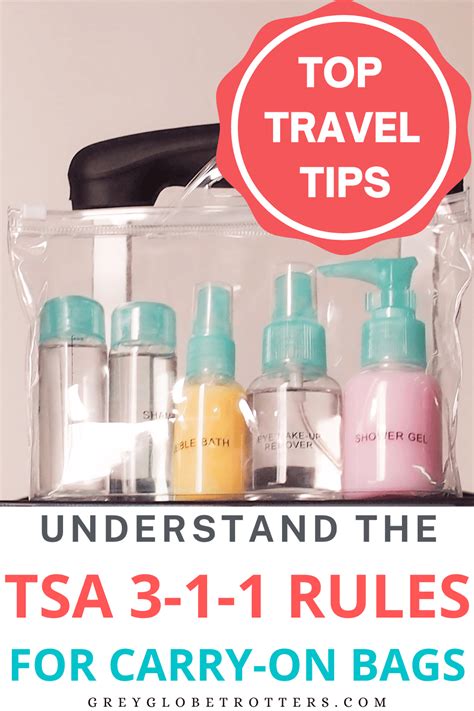Travel Size Liquids Guide

Introduction to Travel Size Liquids
When traveling, especially by air, it’s essential to be aware of the regulations regarding liquids, gels, and aerosols in carry-on bags. The Transportation Security Administration (TSA) has specific guidelines to ensure the safety of all passengers. Understanding these rules can help you prepare for your trip and avoid any issues during security checks. In this guide, we’ll delve into the world of travel size liquids, covering what you need to know to travel smoothly and efficiently.
Understanding TSA Regulations
The TSA’s 3-1-1 liquids rule is a key guideline for travelers. This rule states that liquids, gels, and aerosols in containers of 3.4 ounces (100 milliliters) or less per item are allowed in carry-on bags. These containers must be placed in a clear, quart-sized zip-top bag, with only one bag permitted per passenger. Items such as shampoos, conditioners, toothpaste, and lotions fall under this rule. It’s crucial to check the size of your containers before your trip to ensure compliance.
Preparing Your Liquids for Travel
To make your travel experience smoother, consider the following steps: - Check Container Sizes: Ensure all your liquid, gel, and aerosol containers are 3.4 ounces or less. - Use a Clear Quart-Sized Zip-Top Bag: Place all your eligible items in this bag to make security checks easier. - Declare Additional Items: If you have items that don’t fit in the zip-top bag or exceed the size limit, declare them at security checkpoints. - Pack Essentials in Carry-On: Consider packing essential items like medication, contact lenses, and baby formula in your carry-on, as these might be exempt from the 3-1-1 rule but still require screening.
Exemptions to the 3-1-1 Rule
While the 3-1-1 rule applies to most liquids, gels, and aerosols, there are exceptions for certain items, including: - Medications: Prescription and over-the-counter medications, including those in liquid, gel, or aerosol form, are allowed in reasonable quantities exceeding 3.4 ounces. However, it’s recommended to keep them in their original packaging and be prepared to explain their medical necessity. - Baby Formula, Breast Milk, and Juice: These are allowed in reasonable quantities and do not need to fit in the zip-top bag. They are subject to additional screening. - Duty-Free Items: If you’ve purchased duty-free liquids, gels, or aerosols in reasonable quantities, they are allowed in your carry-on bag, but you must declare them and they might be screened.
International Travel Considerations
When traveling internationally, it’s vital to note that while the TSA regulates flights within and departing from the U.S., other countries may have different regulations. Always check with your airline and the security regulations of your destination country to ensure compliance. The European Union, for example, has similar rules to the TSA’s 3-1-1 liquids rule but might have specific additional requirements.
Traveling with Special Items
For items like contact lens solution, eye drops, and saline solution for medical purposes, the same rules generally apply, but these items are subject to additional screening. It’s essential to declare them and, if possible, keep them in their original packaging to facilitate the screening process.
Checking vs. Carry-On
If you have liquids, gels, or aerosols that exceed the 3.4-ounce limit or prefer not to deal with the hassle of security checks for these items, consider packing them in your checked luggage. This can simplify your travel process but be aware that checked bags can sometimes be delayed or lost.
🚨 Note: Always check the latest TSA guidelines before your trip, as regulations can change. Additionally, consider packing essential items in your carry-on in case your checked luggage is delayed.
Conclusion and Final Thoughts
In conclusion, navigating the world of travel size liquids and adhering to TSA regulations can seem daunting, but with the right knowledge and preparation, you can ensure a smooth and enjoyable travel experience. Remember, the key to hassle-free travel is understanding the rules, preparing your liquids according to the guidelines, and being mindful of exceptions and additional screenings for certain items. By doing so, you’ll be well on your way to a stress-free journey.
What is the 3-1-1 liquids rule?
+
The 3-1-1 liquids rule states that liquids, gels, and aerosols in containers of 3.4 ounces (100 milliliters) or less per item are allowed in carry-on bags, and these must be placed in a clear, quart-sized zip-top bag.
Are there exemptions to the 3-1-1 rule?
+
Yes, there are exemptions for certain items like medications, baby formula, breast milk, and duty-free items. These are subject to additional screening and must be declared.
How do I pack liquids for international travel?
+
For international travel, check with your airline and the destination country’s security regulations. Generally, the 3-1-1 rule applies, but there might be additional requirements or restrictions.